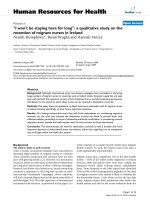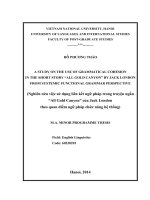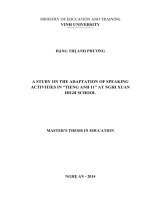Study on determination method of cyclic siloxanes in personal care products collected from Hanoi, Vietnam
Bạn đang xem bản rút gọn của tài liệu. Xem và tải ngay bản đầy đủ của tài liệu tại đây (231.86 KB, 6 trang )
<span class='text_page_counter'>(1)</span><div class='page_container' data-page=1>
<b>Study on determination method of cyclic siloxanes in personal</b>
<b>care products collected from Hanoi, Vietnam</b>
<b>Tran Manh Tri</b>
<b>*</b><b><sub>, Nguyen Le Hoai Linh</sub></b>
<i>Faculty of Chemistry, VNU University of Science, 19 Le Thanh Tong Street, Hanoi, Vietnam</i>
<i>*Corresponding author at: e-mail address: (Tri Manh Tran)</i>
<b>ABSTRACT</b>
Cyclic siloxanes are widely used in beauty products as softener and polisher. Howeve, very few studies have
reported the occurrence and amount of cyclic siloxanes in personal care products (PCPs). In this research, the
analysis method of cyclic siloxanes including octamethylcyclotetrasiloxane (D4), decamethylcyclopentasiloxane
(D5), and dodecamethylcyclohexasiloxane (D6) in PCPs was developed by using a gas chromatography-mass
spectrometry (GC/MS) system. The method detection limits and the method quantification limits of individual
cyclic siloxanes were 0.7 ng/g and 2.0 ng/g, respectively. Mean recoveries of surrogate compound (M4Q) and
target compounds for the procedural blanks ranged from 88.5 to 94.9%. The recoveries of M4Q for real samples
ranged from 75.5 to 120% (RSD: 6.8%). The optimal procedure was appliedto measure the amount of D4, D5,
and D6 in several samples of PCPs including shampoos, hair gels, and shower gels collected from retail stores in
Hanoi, Vietnam. Mean concentrations of D4, D5 and D6 in PCPs ranged of 0.313 – 5.61 µg/g, 0.683 – 11.7
µg/g, and 0.294 – 3.38 µg/g, respectively.
<i>Keywords: siloxanes, PCPs, decamethylcyclopentasiloxane, M4Q, GC/MS.</i>
<b>1.</b> <b>INTRODUCTION</b>
Siloxanes is a large group of organic
compounds with high molecular weights
(about hundreds to hundred thousand Dalton)
in which chains of alternating silicon and
oxygen atoms are linked to aliphatic chains
attached via silicon atoms. Based on the
structure of backbone, siloxanes are classified
into two main groups: linear and cyclic
siloxanes. Cyclic siloxanes with two methyl
groups regarded as aliphatic chains are also
called cyclomethicones. Siloxanes are widely
used in consumer products due to their discrete
properties like low surface tension and smooth
<b>texture. A few studies reported the occurrence</b>
of cyclic siloxanes in personal care products at
high levels. Concentrations of
octamethylcyclotetrasiloxane (D4) and
decamethylcyclopentasiloxane (D5) in
shampoos and hair conditioners were 72.9
μg/g and 1110 μg/g, respectively [7].
Owing to their widespread uses in consumer
products, there is a great potential for the
increase in the concentrations of siloxanes in
indoor environments [4, 10, 11]. In recent
studies, our research group reported the wide
occurrence of cyclic and linear siloxanes in
indoor environments from Vietnam. Total
concentrations of 4 cyclic and 6 linear
siloxanes in indoor air collected from several
Northern cities in Vietnam ranged from 41.8
to 1950 ng/m3<sub> [12]. The occurrence and</sub>
distribution of 5 cylcic and 11 linear siloxanes
were surveyed in 310 indoor dust samples
collected from twelve countries, including
Vietnam [10]. Further, siloxanes were also
found in sludge, sediment, and wastewater
samples [1, 4, 13].
</div>
<span class='text_page_counter'>(2)</span><div class='page_container' data-page=2>
this study, we surveyed the method for
determination of three cyclic siloxanes (D4,
D5, and dodecamethylcyclohexasiloxane (D6)
in PCPs. The optimal method was applied for
detection levels and distribution of cyclic
siloxanes in some genres of PCP samples
collected from Hanoi, Vietnam.
<i>Table 1: Three cyclic siloxanes in this research</i>
Abbr. Name Structure
D4 Octamethylcyclo-<sub>tetrasiloxane</sub>
D5 Decamethylcyclo-<sub>pentasiloxane</sub>
D6 Dodecamethylcyclo-<sub>hexasiloxane</sub>
M4Q
Tetrakis(trimethyl-siloxy)silane
<b>2.</b> <b>MATERIALS AND METHODS</b>
<b>2.1. Solvents and Standards</b>
<i>n-hexane (99.0%) for analysis was</i>
purchased from EMD Milipore Corporation
<i>USA. Acetone, dichlomethane, and n-hexane</i>
for cleaning were purchased from Xilong
Scientific Co., Ltd., China. D4, D5, D6 and
tetrakis(methylsiloxy)siloxane (M4Q) with the
purity of 97% were purchased from
Sigma-Aldrich. M4Q was used as a surrogate
standard. The target and surrogate compounds
<i>were dissolved in n-hexane. Standard mixture</i>
solutions were prepared at different
concentrations ranging from 5 to 2000 ng/mL
<i>in n-hexane.</i>
<b>2.2. Sample collection</b>
Three product categories including
shampoos, shower gels, and hair gels were
purchased from retail stores in Hanoi, Vietnam
from August 2016 to March 2017. Samples
were kept at room temperature until analysis
(before expired date).
<b>2.3. Sample preparation</b>
As there is no siloxane-free sample, one
five-gram sample was chosen to be treated as a
blank. This liquid sample was shaken with 10
<i>ml of n-hexane for 15 min. The solvent layer</i>
was emitted out and the residue was kept and
re-extracted four times as above to make sure
that nearly all the cyclic siloxanes were no
longer in the residue. The final remainder was
acted as a blank.
The samples were pre-extracted similarly as
from following several reports [6, 7, 13] with
slight modification. About 0.1 to 0.3 grams of
sample was weight and placed in a
polypropylene tube. Then, 500 nanograms of
internal standard (M4Q) were spiked. Samples
<b>were shaken for 15 min and centrifuged </b>at
3500 rpm for 5 min. The solvent layer was
transferred into a glass tube. Extraction was
repeated twice more. Total extracted solution
was concentrated to 1 mL by using a gentle
nitrogen stream, followed by quantitatively
transferring into a GC vial.
<b>2.4. Instrumental analysis</b>
Analysis was performed on an Agilent
Technologies 7890GC (for separation)
interfaced with a 5977 mass spectrometer
(MS) (for quantitation) (from Agilent
Technologies, Foster City, CA, USA).
Separation of siloxanes was achieved by an
HP-5MS capillary column (30 m x 0.25 mm
i.d x 0.25 μm film thickness), from Agilent
Technologies. The MS was operated in an
electron impact selected ion monitoring mode
<i>(SIM). Ion fragment m/z 281 was monitored</i>
<i>for D4, m/z 355 for D5, and m/z 341 for D6.</i>
<i>Ion fragment m/z 281 was monitored for M4Q</i>
[11, 12].
Injector and detector temperature were set
at 220 o<sub>C and 280 </sub>o<sub>C, respectively. Two</sub>
microliters of sample was injected at the
splitless mode. The program for the oven
temperature is initially set at 40 o<sub>C in 2.0 min.</sub>
Then, it gradually increased up to 220 o<sub>C with</sub>
the rate of 20 o<sub>C/min and 280 </sub>o<sub>C (held in 10</sub>
min) with a rate of 5 o<sub>C/min. Finally, the oven</sub>
temperature was kept at 300 o<sub>C in 5.0 min [10,</sub>
</div>
<span class='text_page_counter'>(3)</span><div class='page_container' data-page=3>
Fig. 1. Standard chromatograph of cyclic
siloxanes
<b>3. RESULTS AND DISCUSSION</b>
<b>3.1. Blank procedure</b>
Contamination of siloxanes from materials
and solvents in our laboratory has been
examined in an earlier report [12]. Therefore,
efforts to reduce background levels of siloxane
contamination were made. All glassware were
baked at 450 o<sub>C for 20 h and placed in an oven</sub>
at 100 o<sub>C until use. The GC vials were capped</sub>
with aluminum foil, and the solvents were
dispensed directly from new glass bottles (i.e.,
a solvent-bottle that was kept open for more
than a day was not used). Prior to instrumental
<i>analysis, n-hexane was injected into the GC–</i>
MS until the background levels of siloxanes
<i>became stable. n-hexane also was injected</i>
before every sample as a check for background
contamination and carry-over [10, 12].
<b>3.2. Parameters of method</b>
<i>* The method detection limit (MDL) and the</i>
<i>method quantification limit (MQL)</i>
In this research, the instrument detection
limits (IDLs) and instrument quantification
limits (IQLs) on GC/MS system were
respectively 5 and 15 picograms for individual
cyclic siloxanes. The MDL and MQL were
calculated based on the IDLs and IQLs,
sample volume (5 grams), recovery
(88.5-94.9%), concentrated solution volume (1 mL)
and injected volume (2 µL). The MDL and
MQL of individual cyclic siloxanes were 0.7
and 2.0 ng/g, respectively. In general, the
MDL and MQL values met the requirement of
detection method for cyclic siloxanes in PCPs.
<i>* The recoveries and repetitions</i>
Five hundred nano-grams of individual
cyclic siloxanes and M4Q were spiked into
blank samples. The analysis was done
according to the procedure. The recoveries of
target compounds were calculated based on
the initial spiked amount and the determined
amount in spiked samples. The mean recovery
values of cyclic siloxanes and surrogate
compound ranged from 88.5 to 94.9%. The
relative standard deviation values ranged from
7.21 to 13.4% (Table 2).
<i>Table 2: The recoveries of cyclic siloxanes</i>
<i>and M4Q (%)</i>
<b>Times</b> <b>D4</b> <b>D5</b> <b>D6</b> <b>M4Q</b>
1st <sub>78.4</sub> <sub>95.5</sub> <sub>89.3</sub> <sub>91.1</sub>
2nd <sub>83.6</sub> <sub>110</sub> <sub>106</sub> <sub>95.5</sub>
3th <sub>98.5</sub> <sub>75.9</sub> <sub>72.6</sub> <sub>82.4</sub>
4th <sub>75.2</sub> <sub>99.1</sub> <sub>76.6</sub> <sub>101</sub>
5th <sub>97.4</sub> <sub>97.3</sub> <sub>104</sub> <sub>105</sub>
6th <sub>102</sub> <sub>83.5</sub> <sub>98.0</sub> <sub>93.7</sub>
7th <sub>84.1</sub> <sub>87.9</sub> <sub>81.5</sub> <sub>95.4</sub>
<b>Mean</b> <b>88.5</b> <b>92.7</b> <b>89.7</b> <b>94.9</b>
RSD 10.7 11.2 13.4 7.21
Five hundred nano-grams of M4Q were
also spiked into every sample. The recoveries
of M4Q for real samples ranged from 75.5 to
120% (RSD: 6.8%). Concentrations of target
compounds in PCP samples were calculated
based on these values.
<b>3.3. Concentrations of cyclic siloxanes in</b>
<b>personal care products</b>
</div>
<span class='text_page_counter'>(4)</span><div class='page_container' data-page=4>
Fig. 2. Concentrations of cyclic siloxanes in
three kinds of PCPs collected from Hanoi,
<i>Vietnam. Values in parentheses (after kinds</i>
of samples) refer to the number of samples
The results in this research are comparred
with an earlier report. Mean concentrations of
D4, D5, and D6 in hair care products collected
from China were respectively 13.8; 54.2; and
16.7 µg/g [7]. However, previous studies
reported higher concentrations of cyclic
siloxanes in PCPs in comparrison with this
research. Mean concentrations of D4 and D5
in hair gels collected from Canada were 70
and 100 µg/g, respectively [13]. Further, very
high concentration of D5 was measured in hair
care products collected from the United State
and Japan, up to 5890 µg/g [6].
<b>3.4. Distribution of cyclic siloxanes in PCPs</b>
The total mean concentration of three
cyclic siloxanes hair gels, shampoos, and
shower gels were 0.0001%; 0.00005%; and
0.00003% in weight. The results showed that
the total levels of cyclic siloxanes in PCPs
collected from Vietnam were lower than the
values in earlier reports [6, 13]. However,
these results have also explained the wide
occurrence of siloxanes in indoor
environments in Vietnam [10, 12].
</div>
<span class='text_page_counter'>(5)</span><div class='page_container' data-page=5>
Fig. 3. Distribution of three cyclic siloxanes
in PCPs
<b>4. CONCLUSIONS</b>
This is the first study reported the
determination method of cyclic siloxanes in
personal care products in Vietnam. The
chromatographic analysis conditions and the
effective values of the method were surveyed
and optimized. The optimal method was
applied for quantification of three common
cyclic siloxanes in three kinds of PCPs
collected from Hanoi, Vietnam.
<b>REFERRENCES </b>
[1] Bletsou, A.A., Asimakopoulos, A.G.,
Stasinakis, A.S., Thomaidis, N.S., Kannan,
K., 2013. Mass loading and fate of linear and
cyclic siloxanes in a wastewater treatment
<i>plant in Greece. Environ. Sci. Technol. 47,</i>
1824-1832.
[2] Burn-Naas, L.A., Meeks, R.G., Kolesar, G.B.,
Mast, R.W., Elwell, M.R., Hardisty, J.F.,
Thevenaz, P., 2002. Inhalation toxicology of
octamethylcyclotetrasiloxane (D4) following
a 3-month nose-only exposure in Fischer 344
<i>rats. Int. Toxicol. 21, 39-53.</i>
[3] Dekant, W., Klaunig, E.J., 2016. Toxicology
of decamethylcyclopentasiloxane (D5).
<i>Regul. Toxicol. Pharmacol. 74, S67-S76.</i>
[4] Environment Canada, Health Canada, 2011.
Screening assessment for the challenge:
Siloxanes and silicones, di-Me,
hydrogen-terminated: Chemical abstracts service
registry number 70900-21-9. Government of
Canada. Available:
/>ees/default.asp?lang=En&n=4996570F-1#top.
[5] He, B., Rhoders-Brower, S., Miller, M.R.,
Munson, A.E., Germolec, D.R., Walker,
V.R., Korach, K.S., Meade, B.J., 2003.
Octamethylcyclotetrasiloxane exhibits
<i>estrogenic activity in mice via ERα. Toxicol.</i>
<i>App. Pharm. 192, 254-261.</i>
[6] Horii, Y., Kannan, K., 2008. Survey of
organosiloxane compounds, including cyclic
and linear siloxanes, in personal-care and
<i>household products. Arch. Environ. Contam.</i>
<i>Toxicol. 55, 701-710.</i>
[7] Lu, Y., Yuan, T., Wang, W., Kannan, K.,
2011. Concentration and assessment of
exposure to siloxanes and synthetic musks in
<i>personal care products from China. Environ.</i>
<i>Pollut. 159, 3522-3528.</i>
</div>
<span class='text_page_counter'>(6)</span><div class='page_container' data-page=6>
2007. An inhalation reproductive toxicity
study of octamethylcyclotetrasiloxane (D4) in
female rats using multiple and single day
<i>exposure regimens. Reprod. Toxicol. 23, </i>
192-201.
[9] Siddiqui, W.H., Stump, D.G., Plotzke, K.P.,
Holson, J.F., Meeks, R.G., 2007. A
two-generation reproductive toxicity study of
octamethylcyclotetrasiloxane (D4) in rats
exposed by whole-body vapor inhalation.
<i>Reprod. Toxicol. 23, 202-215.</i>
[10] Tran, M.T., Abualnaja, O.K., Asimakopoulos,
G.A., Covaci, A., Gevao, B.,
Johnson-Restrepo, B., Kumosani, A.T., Malarvannan,
G., Minh, B.T., Moon, B.H., Nakata, H.,
Sinha, K.R., Kannan, K., 2015. A survey of
cyclic and linear siloxanes in indoor dust and
their implications for human exposures in
<i>twelve countries. Environ. Int. 78, 39-44.</i>
[11] Tran, M.T., Kannan, K., 2015. Occurrence of
cyclic and linear siloxanes in indoor air from
Albany, New York, USA, and its
<i>implications for inhalation exposure. Sci.</i>
<i>Total Environ. 511, 138-144.</i>
[12] Tran, M.T., Le, T.H., Vu, D.N., Dang,
M.H.G., Minh, B.T., Kannan, K. 2017.
Cyclic and linear siloxanes in indoor air from
several northern cities in Vietnam: Levels,
spatial distribution and human exposure.
<i>Chemosphere 184, 1117-1124.</i>
[13] Wang, R., Moody, R.P., Koniecki, D., Zhu, J.,
2009. Low molecular weight cyclic volatile
methylsiloxanes in cosmetic products sold on
Canada: Implication for dermal exposure.
<i>Environ. Int. 35, 900-904.</i>
<b>Nghiên cứu phương pháp xác định siloxane mạch vịng trong sản</b>
<b>phẩm chăm sóc cá nhân thu mua tại Hà Nội, Việt Nam</b>
<b>Trần Mạnh Trí</b>
<b>*</b><b><sub>, Nguyễn Lê Hồi Linh</sub></b>
<i>Khoa Hóa học, Trường Đại học Khoa học Tự nhiên, ĐHQGHN, 19 Lê Thánh Tông, Hà Nội, Vietnam</i>
<i>* Tác giả liên hệ: Trần Mạnh Trí, địa chỉ email: </i>
<b>TĨM TẮT</b>
Các siloxane mạch vòng được sử dụng rộng rãi trong các sản phẩm làm đẹp như là tác nhân để làm mềm và
mượt. Tuy nhiên, rất ít nghiên cứu chỉ ra sự xuất hiện cũng như hàm lượng của các chất này trong các sản phẩm
chăm sóc cá nhân (PCPs). Trong nghiên cứu này, phương pháp phân tích các siloxane mạch vịng bao gồm
including octamethylcyclotetrasiloxane (D4), decamethylcyclopentasiloxane (D5) và
dodecamethylcyclohexasiloxane (D6) trong PCPs đã được phát triển trên thiết bị sắc kí khí ghép nối khối phổ
(GC/MS). Giới hạn phát hiện và giới hạn định lượng tương ứng là 0.7 ng/g và 2.0 ng/g đối với tất cả các
siloxane mạch vòng trong nghiên cứu. Độ thu hồi trung bình của chất đồng hành (M4Q) và của các siloxane
mạch vòng trong mẫu trắng nằm trong khoảng 88.5 đến 94.9%. Độ thu hồi của chất đồng hành M4Q tiêm vào
trong các mẫu phân tích nằm trong khoảng 75.5 đến 120% (RSD: 6.8%). Quy trình tối ưu đã được áp dụng để
xác định hàm lượng của D4, D5 và D6 trong một số mẫu sản phẩm chăm sóc cá nhân bao gồm dầu gội đầu, keo
xịt tóc và sữa tắm thu mua tại các siêu thị ở Hà Nội, Việt Nam. Nồng độ trung bình của D4, D5 và D6 trong
PCPs nằm trong khoảng 0.313 – 5.61 µg/g, 0.683 – 11.7 µg/g và 0.294 – 3.38 µg/g tương ứng.
</div>
<!--links-->
A study on cognitive metaphors of negative emotions in english and vietnamese
- 13
- 1
- 6








